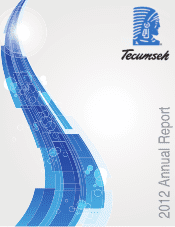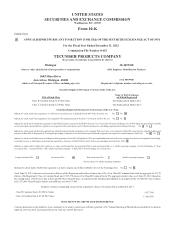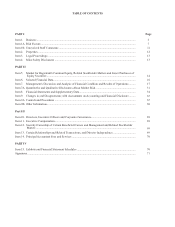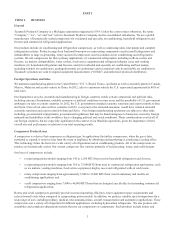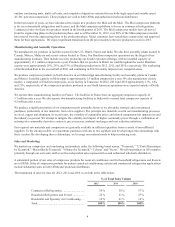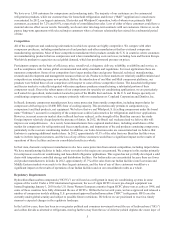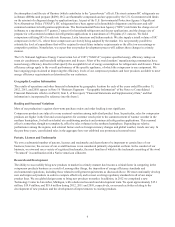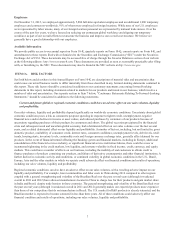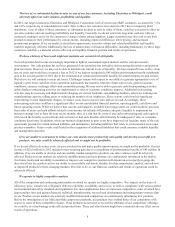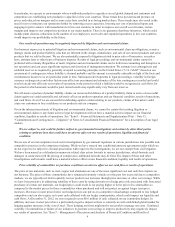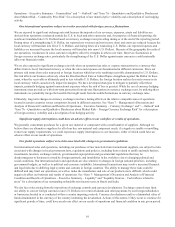Tecumseh Products 2012 Annual Report Download - page 10
Download and view the complete annual report
Please find page 10 of the 2012 Tecumseh Products annual report below. You can navigate through the pages in the report by either clicking on the pages listed below, or by using the keyword search tool below to find specific information within the annual report.9
In particular, we operate in environments where worldwide productive capacities exceed global demand and customers and
competitors are establishing new productive capacities in low cost countries. These trends have put downward pressure on
prices and reduced our margins and in some cases have resulted in us losing market share. These trends may also result in the
need for us to restructure our operations further by removing excess capacities, lowering our cost of purchased inputs and
engaging in joint ventures with manufacturers in low cost countries in order to improve our overall cost structure, restore
margins and improve our competitive position in our major markets. There is no guarantee that these initiatives, which could
include plant closures, reductions in the number of our employees, asset sales and expanded operations in low cost countries,
would improve our profitability in the future.
Our results of operations may be negatively impacted by litigation and environmental claims.
Our business exposes us to potential litigation and environmental claims, such as environmental clean-up obligations, resource
damage claims and product liability suits that are inherent in the design, manufacture, and sale of our current products and some
products that we sold in the past. We are also potentially exposed to litigation related to prior sales of businesses, securities
laws, antitrust laws or other types of business disputes. Results of legal proceedings and environmental claims cannot be
predicted with certainty. Regardless of merit, litigation and environmental claims can be both time-consuming and disruptive to
our operations and can cause significant expense and diversion of management attention. We estimate loss contingencies and
establish reserves as required by generally accepted accounting principles in the United States (“U.S. GAAP”) based on our
assessment of contingencies where liability is deemed probable and the amount is reasonably estimable in light of the facts and
circumstances known to us at a particular point in time. Subsequent developments in legal proceedings, volatility in foreign
currency exchange rates and other factors may affect our assessment and estimates of the loss contingency recorded and could
result in an adverse effect on our results of operations in the period in which a liability would be recognized or cash flows for
the period in which amounts would be paid. Actual results may significantly vary from our reserves.
We self-insure a portion of product liability claims; an unsuccessful defense of a product liability claim or series of successful
claims against us could materially and adversely affect our product reputation and our financial condition, results of operations,
and cash flows. Even if we are successful in defending against a claim relating to our products, claims of this nature could
cause our customers to lose confidence in our products and our company.
Given the inherent uncertainty of litigation and environmental claims, we cannot be certain that existing litigation or
environmental claims or any future adverse legal developments will not have a material adverse impact on our financial
condition, liquidity or results of operations. See “Item 8 – Financial Statements and Supplementary Data – Note 15,
“Commitments and Contingencies – Litigation” of Notes to Consolidated Financial Statements” for a description of our legal
matters.
We are subject to, and could be further subject to, governmental investigations and actions by other third parties
relating to antitrust laws that could have an adverse effect on our results of operations, liquidity and financial
condition.
We are one of several companies involved in investigations by government regulators in various jurisdictions into possible anti-
competitive practices in the compressor industry. While we have entered into conditional amnesty agreements under which we
do not expect to be subject to criminal prosecution with respect to the investigations, we are not exempt from civil litigation.
We have been named as a defendant in numerous related class action lawsuits in various jurisdictions, which lawsuits seek
damages in connection with the pricing of compressors; additional lawsuits may be filed. The impact of these and other
investigations and lawsuits could have a material adverse effect on our financial condition, liquidity and results of operations.
Price volatility of commodities we purchase could have an adverse effect on our cash flow or results of operations.
The price of raw materials, such as steel, copper and aluminum are one of the most significant cost and cash flow impacts on
our business. The prices of these commodities have remained extremely volatile over the past few years and due to competitive
markets, we are typically not able to quickly recover product cost increases through price increases or other cost savings. While
we have been proactive in addressing volatility of these costs by using derivatives to hedge price risk associated with forecasted
purchases of certain raw materials, our hedged price could result in our paying higher or lower prices for commodities as
compared to the market prices for those commodities when purchased and will not protect us against longer term price
increases. Decreases in spot prices below our hedged prices can put us at a competitive disadvantage compared to less hedged
competitors and can also require us to post cash collateral with our hedge counterparties, which could impact our liquidity and
cash flows. At December 31, 2012, we were required to post $0.6 million of cash collateral on our commodity hedges. In
addition, increases in steel prices have a particularly negative impact as there is currently no well-established global market for
hedging against increases in the cost of steel. These hedging activities might not be successful to manage our costs. Continued
volatility of commodities or failure of our initiatives to generate cost savings or improve productivity may negatively impact
our results of operations. See “Item 7 – Management’s Discussion and Analysis of Financial Condition and Results of

